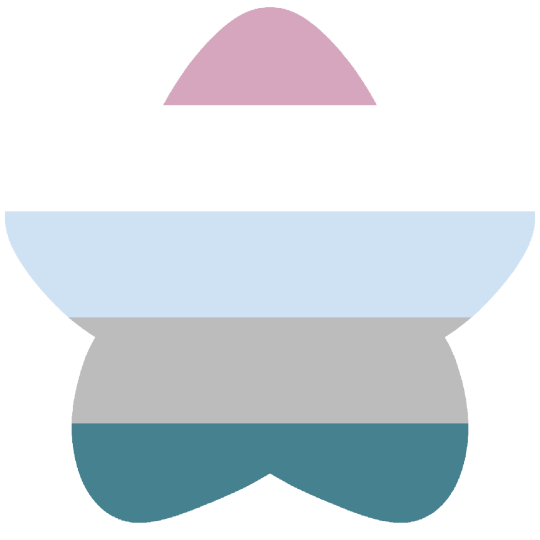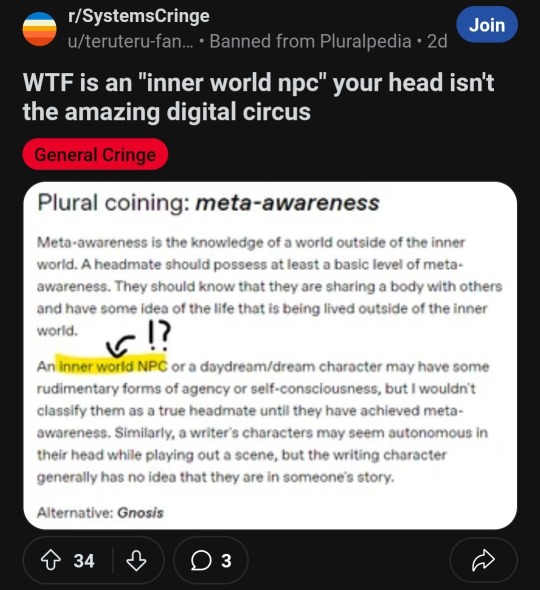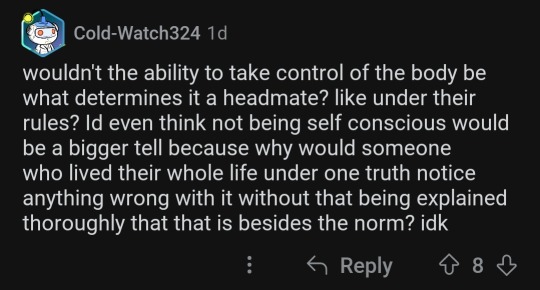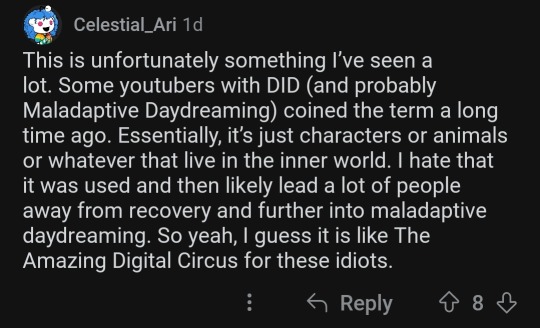#maladaptive daydreaming and plural
Explore tagged Tumblr posts
Text
MaDD and plurality
okay so we're MaDD, right?? and we're also plural??
NOBODY talks about how freaking hard that makes communicating omg.
constantly i'll be trying to talk to someone and then i drift off and suddenly they are completely drowned out OR they're ALSO daydreaming!! it's so frustrating, because it means that to even semi-effectively communicate, i have to talk out loud. if i have to communicate something important and we're in a public place i just have to focus REALLY hard on internal communication and it sometimes STILL doesnt work.
on top of that, we have ADHD so it's even harder, and talking out loud still doesn't work that well because without another person physically here to snap me back to reality whenever i'm daydreaming, if i start daydreaming, i'm just stuck until i realize, which can be anywhere from within a minute to literally 20+ minutes. usually they're able to get my attention by that time, but it's hard because our communication is not easy for anyone but the host(me, who is ALWAYS fronting) to initiate, so unless i actively open myself to communicate with them, it's hard for them to get my attention. sometimes my daydreams even last hours, but that usually doesn't happen when i'm not actively deciding to daydream. so yeah, it's really difficult because i've already got issues focusing, and adding basically irresistable urges to daydream at random that get triggered way too easily on top of that, inner communication is SO HARD.
anyways, this makes making a tulpa really fucking difficult because forcing is really hard.
but here are my tips, for other MaDD, especially anyone making a headmate/alter/tulpa/parogen/whatever themself -
incorporate your daydreaming into the communicating/forcing. like daydream you and that alter hanging out and then communicate via that. this does not ensure that you won't start daydreaming about anything else, but it lessens the chances. if you try to force yourself to not daydream at ALL the urges are gonna be much harder to ignore, at least for me. if you're ALREADY daydreaming, and it gets interesting enough, minor distractions are gonna catch your attention less and less because you WANNA focus on this one daydream. it becomes much more enjoyable.
this kind of like the last one, but this is more specific to tulpa/parogen forcing. don't really view it as a chore, which i've accidentally been doing more and more. not a chore i dislike, but i've been viewing it like something i have to do every single day for x amount of time other wise it wont work and it'll fail horribly and everything will be ruined, when it shouldn't need to be that. it shouldn't be on a to-do list, unless that really works for you(which if that's the case that's freaking awesome and you should probably ignore this tip). idk about everyone else, but it's much easier for me to daydream if i'm treating something like something i need to do because it's so much more tempting to just go live somewhere else for a minute while i do things i need to do. i often daydream doing chores because it's not interesting enough to keep me grounded. so, to make sure it gets done, i drift off while i'm doing it, so i am doing it in the real world but to me i'm in another world or in one of my stories. but for forcing, to be able to do it, you HAVE to be constantly aware and present. if you view it like you're just having a fun little conversation with them, it becomes like whenever you're bored or lonely just like you would reach out to a friend, but instead you're getting some talking to your head friend in. even if it's not traditional forcing, it works and develops them more, even if it's just a bit here and there. idk about everyone else, but i think partially because of my ADHD and partially because of my MaDD, whenever i have a chore i need to do i kind of put it off if i'm already doing something. i don't really *want* to put it off, but i just can't get my body to move. especially when I'm daydreaming. because, why would i get up and do the boring thing when i can watch my story in my head ? it's so much easier to sit and do nothing. but as we all know, that ADHD paralysis is so so SO stress inducing, the best option is to always get up and try to force yourself to. idk if non-ADHD MaDD will relate at all though, because that paralysis is mostly exclusive to those with ADHD afaik, but for me, my MaDD makes it much worse. anyways, that probably didn't make much sense sorry
write down what everyone is saying. this makes it much easier to keep track of what they are saying and stay present, but it also documents the conversation as well. so even if you weren't that present during the conversation, or you're worried you'll forget something important, you'll have a record to read back on later if you need! and also with created alters/headmates, keeping track of their progress is always incredibly important!!
don't listen to music! this one might be a bit of a given but unless it's like instrumental music that you genuinely won't pay that much attention to but still helps you focus, DON'T listen to it. songs are an easy gateway into a daydream. ESPECIALLY songs with lyrics, even ones that you can't understand because they're in another language, which by the way for literally any other thing you need to focus on, that's a great tip, listening to music in other languages, because you can still focus with interesting music in the background but the lyrics arent grabbing you at all. anyways back to plural-related MaDD tips, yeah, don't listen to music. even if that song usually doesn't catch your attention. for me, if i'm talking, internally or externally, and there's music with lyrics playing, i reallyyy cannot focus on what i'm(or others, again, internally or externally) are saying. idk, might just be some sort of auditory processing issue related to my ADHD but i cannot focus on it, and because it's hard, i just need to pick one, and sometimes my brain picks the song and i just. stop talking. and start daydreaming.
idk what to do if you're not fronting and trying to communicate with whoever is fronting, because i've not switched(like i mentioned before, the host, who is me, has never not been the one fronting), but if anyone has any other tips either related to that or the ones i already have here, please feel free to let me know because i'd love to hear them and i'm sure others do too!! anyways, i hope i helped, idk this might be too specific to me.
#endo safe#plurality#pro endo#multiplicity#plural system#maldaptive daydreaming disorder#actually madd#maladaptive daydreaming#madd#just madd things#madd things#madd tips#madd & plural#maladaptive daydreaming and plural#anti endos probably wont like this but uh i guess this could be relevant to them?#i'm endo so like#they probably will respect this less#and have probably already scrolled past#but if you're still here hi#hope this is helpful anyways#we're not a system btw#just plural#hence no switches#anyways#anti endos pls dni :)#unless you got a cool tip or smfn#endogenic system#endogenic#actually did#did osdd
36 notes
·
View notes
Text
y'all. please please please, do not just be weird. be complicated too. have a bunch of different pronouns, have a dozen names, have a hundred labels for you experience or have not a single one because it's too complicated to even explain
Be complicated, and be complicated with courage
714 notes
·
View notes
Note
Some of these syscringers are actually stupid

The comment was found under this post btw
https://www.reddit.com/r/SystemsCringe/comments/1h8r3bt/thoughts_on_this/#lightbox
LOL! Really! I'm so confused by this! MAYBE you could argue it's not a disorder in the way it hasn't been included in the DSM or ICD yet. But it's also considered a dissociative disorder by the psychiatrist who coined it. It doesn't matter that it hasn't gotten official recognition yet and you can't officially diagnose it. It also meets the DSM's definition of a disorder even if it's not actually in the DSM.
#syscourse#maladaptive daydreaming#madd#systempunk#syspunk#pro endogenic#pro endo#sysblr#mental health#psychiatry#psychology#multiplicity#actually plural#actually a system#r/systemscringe#systemscringe#hate groups#hate group
49 notes
·
View notes
Text
Userbox saying "This ___ has MaDD"!!
Plural/system/etc.:



Headmate/alter/etc.:



Other:


#pro endo#plural gang#pluralgang#actually plural#plurality#plural community#MaDD#maladaptive daydreaming#actually maladaptive#actually madd#userbox
54 notes
·
View notes
Text
System origin of the day ; Araisagenic

Araisagenic is an origin for systems formed through MaDD and escapism. Headmates are created in paracosms, or influenced by them. They may evolve into other origins over time.
It is an adaptive origin.
#system terms#endo friendly#endo safe#endo system#endogenic friendly#endogenic safe#endogenic system#endo#plural system#pluralgang#plurality#madd#maladaptive daydreaming
51 notes
·
View notes
Text
Araisagenic : systems who are formed through MaDD and escapism, where headmates are created in paracosms or influenced by them. The headspace of an araisagenic system may also fuse with the system's or members' paracosms and parames.


#araisagenic#maladaptive daydreaming#maladapting daydreaming disorder#MaDD#origin terms#system origins#origin flags#origin flag#actually plural#plural community#plural stuff#plural system#pluralgang#plurality#web resources#pride stars#adaptive origin#adaptive system
21 notes
·
View notes
Text
Some Valentines Day userboxes!!






Made some for people whose valentine isn’t on this plane of existence :3
(Note; the term F/O stands for fictional other
The term ‘para’ relates to MADD (maladaptive daydreaming)
And DR stands for ‘desired reality’ and it comes from reality shifting!)
#valentines day#valentine#happy valentines#lovecore#f/o#romantic f/o#f/o stuff#f/os#f/o community#in sys#graphics#web graphics#userbox#did alter#dissociative system#alterhuman#plural userboxes#maladaptive daydreaming#actually maladaptive#maladapting daydreaming disorder#DR#reality shifting#desired reality#shifitng
33 notes
·
View notes
Note
Plural with MaDD culture is "did I actually have this interaction with an alter or did I daydream it? How much of this is headspace and how much is daydreaming? Is any of this system stuff or am I just daydreaming? Am I really daydreaming or is it system stuff? You'd think figuring this out would be easy."
-🐤
.
#endos dni#osdd#pdid#did#did system#pdid system#osddid#actually did#traumagenic#actually dissociative#plural culture is#madd#maladaptive daydreaming
113 notes
·
View notes
Text
when my unhealthy coping mechanism starts actually being unhealthy and causing panic attacks

cmon maladaptive daydreaming, you’re supposed to help, not make it worse. why are you not working?
#traumagenic system#actually plural#actually did#did community#endos do not interact#sysblr#plural system#did#mental health#me when the mental illness is mental illnessing#actually dissociative#maladaptive daydreaming
37 notes
·
View notes
Text
How do you explain to those without MaDD that we don’t want to get rid of this disorder, even if it’s ruined our lives in more ways than one- we want to keep it because it’s also what’s kept us alive, and it’s part of us. Without it, there’s not much of us left because it’s created such an impact on our lives that it’s better to keep it now than get rid of it. It’s not curable, it’s not easy to cope with, and it’s not “fixable” but it can be managed. The difficult thing is we don’t want to manage it, that’s where the addiction comes in. We don’t want to manage it or get rid of it even if it harms us, because it’s been here for so long and the hole it’s made in our identity would create an even bigger one without it. So it’s very very hard to explain to others that we want to keep it even if it’s harmful, it allows us to escape and cope while keeping us sane and alive. A horrible, yet wanted disorder. Getting rid of it would mean getting rid of the people in your head, saying goodbye to them and never seeing nor speaking to them again. Our minds would go quiet, not a single voice nor place to escape into.
We need it just as much as it hurts us. -glo
#actually madd#madd#maladapting daydreaming disorder#maladaptive daydreaming#maladaptive problems#plural#theglowormscheme#daydreamer#answering asks#just thoughts
35 notes
·
View notes
Text

this user has autism, adhd, and several disassociative & mood disorders. please be patient.
#userbox#plural userboxes#userboxes#sysboxes#system userbox#this user#cdd#actually maladaptive#maladaptive daydreaming#audhd#mild mannered cannibal .
33 notes
·
View notes
Text
Answers for r/systemscringe

It seems like the subreddit is now denying the existence of imagination.
An NPC is a character in your head who you may or may not control but also isn't really a person.
You may have experienced something like this when you dream, where the other characters in the dream are completely autonomous. Although with the intelligence level of your subreddit, I wouldn't be surprised if you start claiming that dreams don't exist either.
If you were to head over to the immersive daydreaming subreddit, you would find a community that has a lot of these sorts of non-headmate characters. (And probably a few headmates that they don't realize are headmates.)

It's 2024. When are you guys going to finally learn that partial dissociative identity disorder exists? A dissociative disorder that is characterized by a lack of switching. Switching in that disorder is either rare or non-existent.
This has been in the ICD-11 since 2019. You all have had 5 years to educate yourselves!
You can't keep relying on other people to do it for you. Especially when you ban us for trying!
I'm not really sure that I understand what this user is getting at with the point about self-consciousness. I think that they are suggesting that a person who was plural wouldn't realize that they were plural because it would just be normal to them?
Which can be true if they aren't talking to people about their internal experiences, but isn't really what I'm talking about here.
When I refer to a rudimentary self-consciousness, what I am meaning is that the headmate should have its own perspectives and be able to have some awareness that those perspectives are their own and not someone else's.
The most basic version of this is an entity who could say, "I like x where you like y" to the host. This involves an implicit acknowledgment of separation. Whether the headmate is calling itself a person or a part or a spirit or something entirely different, it is aware of its own wants and desires, and that those wants and desires aren't necessarily shared by everyone in the system.
This basic level of self-consciousness isn't indicative of a headmate on its own though. Dream characters may also demonstrate this basic sort of self-consciousness. So can some daydream characters.
And lines can get blurry quickly if you have a system who is in an inner world together which is sort of like a shared daydream. Not everything that can talk in the inner world is going to be a full headmate. Some are going to be like the daydream characters of singlets. These are what we call NPCs.

Super important reminder that immersive daydreaming exists without being maladaptive!
Systems immersing themselves in the inner world can be healthy because it can allow them to develop stronger bonds with each other and lower dissociative barriers.
And even immersive daydreaming can be healthy for singlets simply because it's fun and can relieve stress. You could say somebody sitting around daydreaming for hours is dangerous but if they enjoy it, I don't really see it being any more dangerous than playing a video game a lot or other activities that don't involve social interaction. And I think it might be far more healthy than mindlessly scrolling through YouTube shorts or TikTok while they slowly deteriorate your attention span.
Daydreaming only becomes maladaptive whenever it starts to impact your life in unhealthy ways.
This really isn't that complicated!
#syscourse#maladaptive daydreaming#immersive daydreaming#madd#paracosm#daydreaming#imagination#sysblr#systempunk#syspunk#plural#plurality#multiplicity#actually plural#actually a system#endogenic#pro endogenic#pro endo#systemscringe#r/systemscringe#hate groups#hate group
57 notes
·
View notes
Note
could maladaptive daydreaming develop into did/osdd?
No, not necessarily
Maladaptive and immersive daydreaming is frequently related to trauma, but not always
Alone, it wouldn't develop into alters or a CDD, but a MASSIVE number of people who develop a CDD experienced MaDD along with it, with comorbidity rates at nearly 40%
They're related in causes and mechanisms but not causative of each other
Edit to add: this doesn't touch on endogenic plurality and madd, which possibly has a much closer relation
#syscourse#pro syscourse conversation#sysconversation#did#osdd#not syscourse#pro endo#system safe#plurality#dissociative disorder#osdid#osddid#maladaptive daydreaming#madd
15 notes
·
View notes
Text
MADD + system culture is not being sure if you are a new headmate or if you are just having a very deep and long daydream
#system culture is#madd system culture is#maladaptive daydreaming disorder system culture is#plurality#actually plural#actuallyplural#plural system#pluralgang#multiplicity#actually multiple#actuallymultiple#madd#maladaptive daydreaming#maladaptive daydreaming disorder
44 notes
·
View notes
Text
Honestly, real talk, I feel like people largely do not understand just how much characters within those who are maladaptive daydreamers and/or were maladaptive daydreamers literally are "parts of them" and how both healing and destructive that dynamic can be and I find that a bit visible with how people in DID communities talk about maladaptive daydreaming as a "form of plurality"
Its an absolutely different experience but that doesn't mean that the label of "plural" isn't equally suitable. Since that topic has come up on our radar like way back half a year or year ago, we honestly have been thinking about it as someone who is considered "recovered" from DID and has recovered from maladaptive daydreaming but still has a brain that functions creativity and imaginative worlds with the same semi-autonomous functions whether I like it or not
And honestly? My characters are very much not "my creation", nor are they "just my OCs" - the very way all of my character are made and at this point the only way I know how to write and make characters is by taking a part or aspect of myself (conscious or subconscious) and throwing it out there with a name and face. That part of myself engages with the world I created and develops within the narrative and impacts the world itself.
I repeat and do this for all my characters and the world that I have created serves as a hypothetical exploratory way to understand, engage with, and explore very complex topics with exaggerated and isolated parts of myself. I have never really "planned" a character of given them traits or really anything other than a basic premise of a name, MAYBE a gender, and a vague role and I let them define their own story. No real character arc planning. No real likes and dislikes. No real narrative or secret message.
The function and means of which that I "created" these OCs and the level of which I don't control the way they form and grow is extremely similar to how I "create" alters, albeit one is far more voluntary and intentional than the other and one is physically sharing my life with me and the other is sharing a mental world with me.
((Additionally I don't engage in the mental world I made for them beyond the half joke that I'm the god of the gods of that world and they dont know))
The dynamics I have with my characters is WAY WAY WAY different than my parts / alters but BOTH my characters (maladaptive daydreaming) and my alters (DID) are equally fair to call "parts of me" and "parts of a whole" in a very literal not "Oh yeah Im a writer and this character means a lot to me theyre a part of me"
With my writing partner (who does this as well) we regularly use our characters as well to explain what we are going through / how we are feeling to help facilitate real talk and venting a lot because we have a mutual understanding that while this is a story and these are our characters, both of us have "built" this world by literally giving very specific aspects of ourselves the ability to explore, grow, and learn in a world and that while some have grown SO far from who we are now, they represent an aspect and potential part of us that could have been should something have gone one way in a specifically extreme way in a specific environment.
With that in mind, I absolutely feel its fair to compare DID and MaDD "plurality" with some obvious understanding that while there are similarities they are also different (AND THATS OK).
Cause honestly? If I actually talked to my characters (like a lot of people with MaDD tend to do) I could see myself calling and feeling as though they were a system and I don't think it would be all that inaccurate and wrong. I don't have that experience as my MADD and DID are mostly entirely two seperate dissociative coping mechanisms, but I know for a fact the line between the two is a lot less clear and its just food for thought
-----------------
[SYSCOURSE AND DEBATE WILL BE BLOCKED.]
[Good faith conversation and discussion is WELCOMED and ENCOURAGED.]
[If you don't know the difference, don't add on.]
#alter: fei#alter: riku#maladaptive daydreaming#plurality#plural#conversysion#sysconversation#sys conversation#system discussions#syscourse#<- for reach because I don't think the new tags have gotten well known enough#actuallydid#dissociative identity disorder
133 notes
·
View notes
Text
I love you, those who don’t fit the societal norm
I love you, those who dress alt
I love you, physically disabled folk
I love you, neurodivergent/mentally ill/mentality disabled folk
I love you, non human folk
I love you, plural folk
I love you, maladaptive daydreamers and immersive daydreamers
I love you, those who use create/experience alterreality
I love you, voluntary systems,kins,bonds etc
I love you, everyone who has been outcasted for existing, you are welcome in our hearts <3

#positivity#alterhuman#plurality#neurodivergent#immersive daydreaming#maladaptive daydreaming#disability#alterreality#soulbonding#munbonding
9 notes
·
View notes